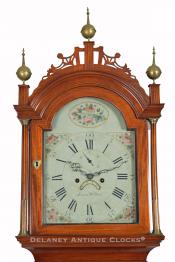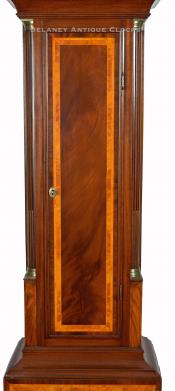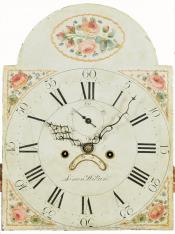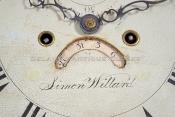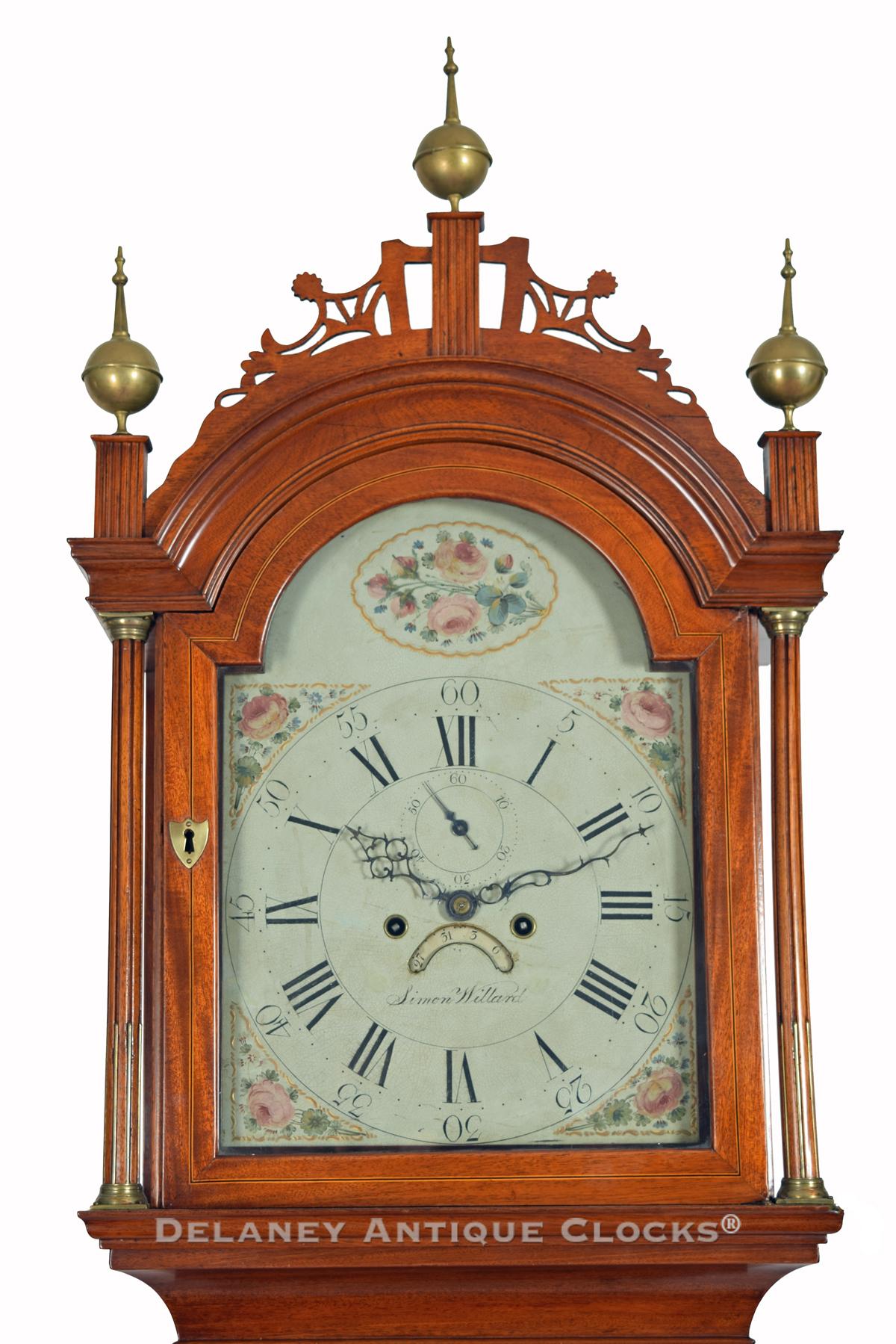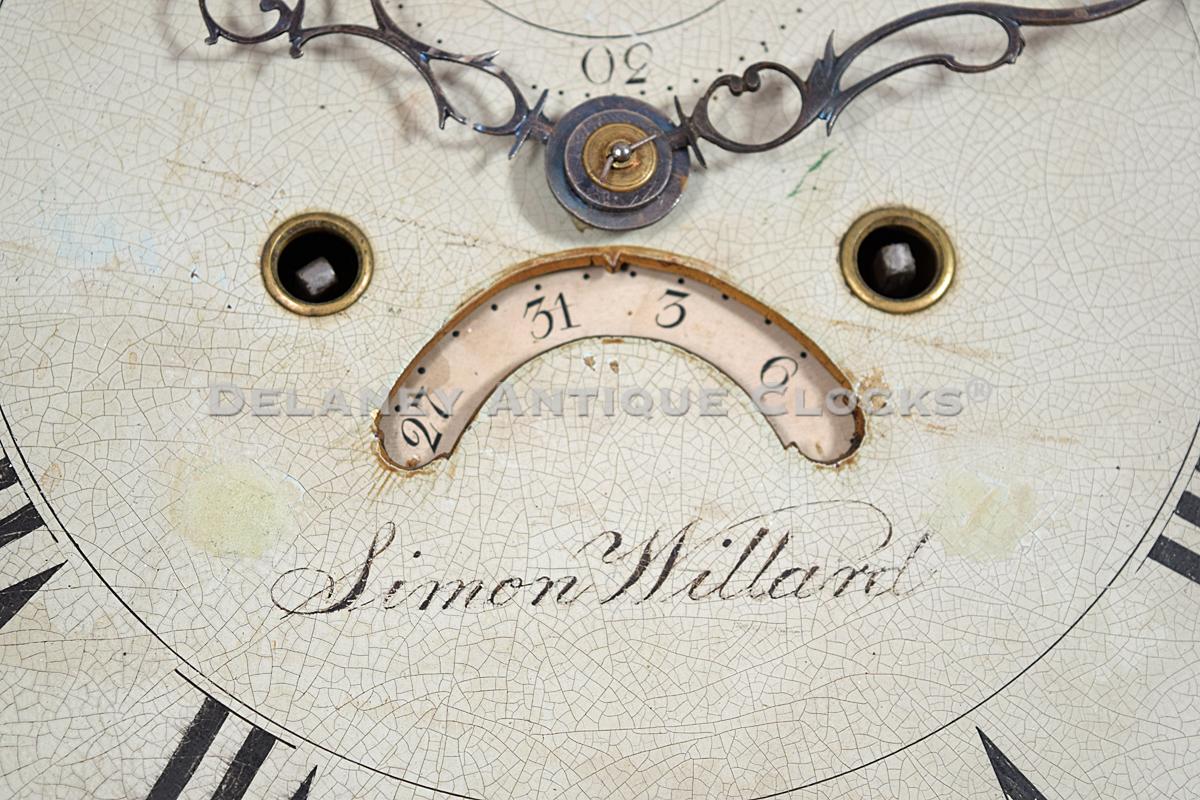Simon Willard of Roxbury, Massachusetts. An attractive cross-banded mahogany-cased tall clock. 222119.
This complex inlaid mahogany case has outstanding narrow proportions standing 7 feet 11.5 inches tall to the top of the center finial. This is a handsome example, epitomizing the "Roxbury" form that became very popular in Boston in the late 1700s. So much so that it influenced many New England clockmakers during the early 19th century. The clocks, produced in the Boston borough of Roxbury, possess pleasing proportions, high-quality construction, brass stop fluting, and choice-figured mahogany. This fantastic example was produced by Boston's premiere clockmaker Simon Willard.
The case stands on four nicely formed ogee bracket feet applied to a double-stepped molding. The base panel and the waist door share the same formatting of veneers. Both forward-facing panels are veneered with vibrantly-grained selections of crotch mahogany. Both veneer panels are nicely shaded from light browns across the color spectrum to black. A thin light-lined inlay frames the three individual rows of cross-banding. The innermost band is veneered in flaming birch. This lightly colored wood has a distinctive, vibrant grain structure. The middle band of the inlay is made of tiger maple. Its grain pattern is linear and stands out as compared to the waves exhibited in the birch. The last outermost band is mahogany, which frames the panel's perimeter. The contrasting colors of the darker mahoganies and the maples command one's attention. One should also notice the color shading of the larger mahogany panels. This has a wonderful effect on the case presentation. The waist door is fitted with an applied molding. One would open this door to access the inside of the case. Here, the original wooden pendulum rod, brass-faced bob, rating nut, and two red-painted tin can drive weights are accessible. The door is flanked by brass stop-fluted quarter columns that terminate in brass quarter capitals. Rectangular panels are under each quarter column. These are decorated with a line inlay pattern consisting of light and black stringing. The bonnet features a traditional New England pierced and open fretwork design. This is supported by three fluted and capped plinths. Each supports a brass ball and spike finial. Fully turned and brass stop-fluted bonnet columns visually support the upper bonnet molding. They are mounted in brass capitals and are free-standing. The sides of the bonnet are fitted with tombstone-shaped side lights. The arched bonnet door is lined inlaid and fitted with glass. It opens to access the colorfully painted iron dial.
This colorfully painted iron dial was manufactured in England by the Wilson firm. It is fitted with a false plate and is signed at the top. The dial is a standard size measuring 12 inches across. The four spandrel areas are decorated with colorfully painted floral patterns. Roses are the predominant theme. This is also true of the oval-shaped decoration featured in the arch or lunette. Large Roman-style numerals indicate the hours. A dotted minute ring separates them from the Arabic five-minute markers. A subsidiary seconds dial and a calendar dial are displayed in the traditional locations. This dial is signed by the clockmaker, "Simon Willard," in script-style lettering.
The weight-driven movement is constructed in brass and is of good quality. Four turned pillars support the two brass plates. Hardened steel shafts support the polished steel pinions and brass gearing. The winding drums are grooved. The escapement is designed as a recoil format. The movement is weight driven and designed to run for eight days on a full wind. It is a two-train or a time-and-strike design having a rack and snail striking system. As a result, it will strike each hour on hour. This is done on a cast iron bell which is mounted above the movement.
This beautiful clock was made circa 1795. It stands just under 8 feet tall (81.5 inches) to the top of the center finial. The upper bonnet molding measures 19.5 inches wide and 9.25 inches deep.
Inventory number 222119.
Simon Willard was born in Grafton, Massachusetts, on April 3, 1753. He was the seventh of twelve children born to Benjamin Willard (1716-1775) and Sarah (Brooks) Willard (1717-1775) of Grafton. While living in Grafton, Simon answered the Lexington alarm on April 19, 1775, along with his brothers. It is thought that by 1782 he moved from Grafton and took up residence in Roxbury as a Clockmaker. Simon became a Master Clockmaker as well as an inventor. He is well known for receiving patents for his roasting jack in 1782, his "Improved Timepiece" or Banjo clock in 1802, and an alarm clock patent. In addition, he trained many men to make clocks who became well-known Clockmakers once their apprenticeships were served. Some of them include the brothers Levi and Able Hutchins, Elnathan Taber, William Cummens, Ezekiel Jones and Daniel Munroe. Some of the more notable public clocks Simon built include the clock in the United States Capitol building's Statuary Hall. He also built a clock for the House of Representatives and the U. S. Senate. Simon died on August 30, 1848, at the age of 95.




